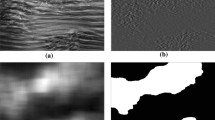Abstract
In this paper we propose a new method which might be useful to investigate the flow fields close to vaulted walls with spatial and temporal resolution. This kind of flow visualization is important in the field of biofluid mechanics, since a close relationship is assumed between flow and biological phenomena. This new method is non-invasive, and is also applicable for unsteady flows. It has been used to investigate the steady and the unsteady laminar flow in a rectangular duct, as well as the steady, laminar flow in two different U-shaped ducts, both with a backward facing step, one having a rectangular cross-section, the other a nearly elliptical cross-section. The results concurred well with analytical or numerical solutions.
Similar content being viewed by others
References
Asakura T. and Karino T., Flow patterns and spatial distribution of atherosclerotic lesions in human coronary arteries, Circ. Res., 66 (1990), 1045–1066.
Asztalos B., Yamane T., Nishida M., Masuzawa T. and Konishi Y., Evaluation of shear and recirculation in centrifugal artificial heart by flow visualization, J Visualization, 3-1(2000), 79–92.
Heinzen Ch., Herstellung von monodispersen Mikrokugeln durch Hydroprilling, (1996), Eidgenössische Techn. Hochschule, Zürich.
Hu H., Saga T., Kobayashi T., Okamoto K. and Taniguchi N., Evaluation of the cross correlation method by using PIV Standard Images, J Visualization, 1 (1998), 87–94.
Kroll M. H., Hellums J. D., McIntire L. V., Schafer A. I. and Moake J. L., Platelets and shear stress, Blood, 88-5 (1996), 1525–1541.
Nerem, R. M., Alexander, R. W., Chappell D. C., Medford R. M., Varner S. E. and Taylor W. R., The study of the influence of flow on vascular endothelial biology, Am J Med Sci, 316-3 (1998), 169–175.
Morton W. and Cumming R., A technique for the elucidation of Virchow’s triad, Ann NY Acad Sci, 283 (1977), 477.
Author information
Authors and Affiliations
Corresponding author
Additional information
Perrine Debaene: She received her Diploma in Biomedical Engineering — Biomechanics/Biomaterials from the Technological University of Compiègne, France, in 2001. She wrote her diploma thesis at the Biofluidmechanics Laboratory, Charite Berlin, about the flow visualization in a blood pump of a ventricular assist device. Perrine Debaene has worked as a research assistant in this laboratory since 2001. She defended her Ph.D. thesis, which was supported by the German National Academic Foundation, in April 2005. Her research interests are quantitative visualization, PIV, flow in natural and artificial organs and biomechanics.
Ulrich Kertzscher: He received his diploma in Physical Engineering from the Technical University Berlin in 1989, and his doctorate (Eng.) from the Technical University Karlsruhe in 1994. Since 1997 Ulrich Kertzscher works at the Biofluidmechanics Laboratory, Charite Berlin, as a research assistant. His research interests are quantitative visualization, PIV, flow optimization of the artificial organs and analysis of the blood flow in the native vessels.
Leonid Goubergrits: He received his MSc (Physics) in Fluid Mechanics in 1993 from the Moscow Institute of Physics and Technology, Department of Aeromechanics and Flying Machines. He also received his doctorate in Engineering in 2000 from the Technical University of Berlin. Since 1996, Leonid Goubergrits works at the Biofluidmechanics Laboratory, Charite Berlin, as a research assistant. His research interests are Quantitative Visualization, PIV, CFD, flow optimization of the artificial organs and analysis of the blood flow in the native vessels.
Klaus Affeld: He received his diploma degree in Aircraft Engineering in 1962 and his doctorate (Eng.) in fluid mechanics in 1969 from the Technical University Berlin. He worked at the institute of aircraft engineering in Berlin before starting his doctorate. After obtaining his doctorate, he worked as a researcher in Biofluidmechanics in the development of an artificial heart and taught Biofluidmechanics at the Technical University Berlin. In 1987, he founded the Biofluidmechanics Laboratory within the Charite. His research interests are blood flow including flow in artificial organs, experimental methods in fluid mechanics, biomedical engineering and biomechanics.
Rights and permissions
About this article
Cite this article
Debaene, P., Kertzscher, U., Goubergrits, L. et al. Visualization of a wall shear flow. J Vis 8, 305–313 (2005). https://doi.org/10.1007/BF03181549
Received:
Revised:
Issue Date:
DOI: https://doi.org/10.1007/BF03181549




